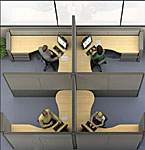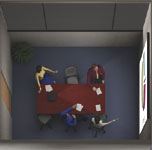The Essential Design Element for Any Office Space
The office building has become a flagship communicative hub reinforcing corporate culture, collaboration, and development. Office space design increasingly incorporates elements of branding and corporate identity into a structure with colors, credos, and furnishings. Open office spaces, atria, and cafeterias encourage informal communication between teammates that is invaluable for keeping people informed and generating ideas. Communication frequently occurs face-to-face or over cyberspace. AV presentations, intercontinental teleconference calls, e-mails, and text messages are important mediums that the office space must be able to accommodate. Office buildings provide a medium to communicate corporate identity and brand. Office design builds bridges between employees, facilitating communication, information transfer, and interpersonal collaboration.
The popularity of rigid private-office-heavy floor plans has waned in favor of highly adaptable, partitioned spaces with modular office furniture systems. This new design allows spaces to be quickly and easily reorganized to match changes in corporate strategies and initiatives. Individual cubicles merge to create a collaborative team environment. Longer tables and whiteboards are partitioned off to quickly create project rooms or other needed conference areas. The International Facilities Management Association (IFMA) quoted the current inter-corporate churn rate at 41%, which means that almost half of the employees in an office space are physically moved to a different location within the same company every year.
|
|||||
Perhaps the most fundamental difference between the organizational needs of 1960 and today is the fierce competition to hire and retain quality employees. Talent is viewed as the most scarce and valuable resource that a company can obtain. Subsequently, employees’ salaries and benefits are by far the largest expense that an office building incurs. Office spaces are tasked to provide productive and interactive work environments, and to serve as tools for employee comfort, satisfaction, and retention. It is essential that the design of the office space support these efforts, simultaneously communicating to employees that they are important and valued by the firm.
Amidst the tumult of intense competition, quick strike and counterstrike initiatives, continuous reorganization, and a team roster that is constantly in flux, concrete and glass provide the semblance of stability, purpose, and success. The employees and floor plans will change, that is the nature of business. The office building will stand, that is the nature of architecture.
Benefit from the Building
Keeping an office building capable of supporting organizational needs is an essential element of good business, underscored by the fact that, for many companies, the physical building is the most expensive capital asset on the balance sheet. In fact, the significant investment required to construct, operate, maintain, and repair an office building (an investment that often represents between 10-20% of a company’s annual revenue) creates a strong demand from building owners and shareholders to pinch every last benefit out of the built environment. “Failure to wring every benefit out of the most expensive capital asset most companies have would not be countenanced in any other aspect of corporate life” (Seiler, John A. 1984. Architecture at Work. “Harvard Business Review,” September/October, 120).
Reducing the amount of money required to operate the building can significantly affect the bottom line and is often easily accomplished by improving the efficiency of various building systems, like lighting, heating, or cooling. But opportunities to squeeze the maximum benefit from a building asset exist beyond improving its operational efficiencies. Buildings can be designed to create value for the company, one square foot at a time.











